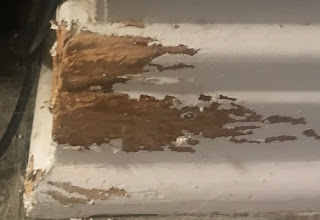*disclaimer - I have not been endorsed or supported by any of the products mentioned in this blog. I have however used them in my own training journeys and found them to be very useful*
One problem behavior that almost all pet parents have to deal with at some point in their furry companion’s life is chewing. I often have pet parents that come into their first class with me and are beyond frustrated that their beloved pup is chewing up their shoes or phone chargers. Or if your me, you walked into your kitchen and found this...
For puppies and adolescent dogs, it’s a way to reduce the pain of teething. Chewing also helps to promote healthy teeth and gums by increasing the flow of a dog’s antibacterial saliva. When a dog chews on something it stimulates the Adrenal-Pituitary Axis, which is part of a dog’s Neuroendocrine system which helps to regulate stress with the release of endorphins making chewing a self-soothing behavior.
 |
| Yadi with a Buffalo Horn |
Puppies set about exploring life with their mouths. They learn taste, texture and sound by manipulating objects with their mouths. As they look at their environment around them, anything within their reach is fair game until they are taught otherwise. I’ve often said that we accidently teach our dog’s 98% of their bad habits by not understanding how they interpreter our responses to their actions. Chewing on inappropriate objects is a huge example of this.
Think about this from your pup’s point of view. You come home and your dog is chewing on one of your favorite shoes. What do you do? 95% of us will yell “NO” with some excitement in our voice and move toward our dog to take the shoe, right? Your dog doesn’t want to give up the fun toy that got you so excited when you came home so she grabs it and races down the hall. You give pursuit because you need to get the shoe away from her.
Now pup is super happy because you have responded to her chewing your shoe with a game of chase. How much fun is your pup having? Is this really something your pup is going to avoid doing in the future? The answer is no!
Part of being a pet parent means that you are either in constant training mode, or management mode. All items that could be fun for your dog to chew on that are not appropriate need to be removed from their area when they are unsupervised. Remember your pup is essentially a 2-year-old toddler emotionally. They have no concept of value, or ownership (in the sense that we consider ownership). Our dogs only learn to do the things that WE teach them to do.
So how do you teach your dog not to chew on inappropriate things? I’m so glad you asked!
The first step of teaching our dogs what not to chew on, is to teach them what they are allowed to chew on. Sound to simple? I promise you it’s not. Our dogs learn that things that work to get our attention are the things they should do again. Remember that game of chase down the hallway trying to get your shoe back? How much attention did your dog think she was getting? (A TON!!!) Surround your dog with the things that they are going to get your approval for chewing on and then, and this is the most important part, reward them for chewing on those things.
One of my favorite interactive toys is the Kong, or the Busy Buddy Squirrel dude. Both of these toys are hollow, and you can stuff them with different types of treats or food. The Kong Company even has an interactive recipe guide at their website www.kongcompany.com
My pup Yadi loves a natural peanut butter mixed with his kibble in his. I put this in the freezer for an hour or so until the peanut butter is firm, and it keeps him busy for an hour or more.
Some other great treat toys are things like snuffle mats made of fleece where you can scatter their food or treats into the mat so that they have to search for it. These are great for nose work or slow feeding options as well. Trixie Flip Board games for dogs also have several levels of puzzles where your dog has to learn to use their nose, and feet to find the hidden treats. There are also all the natural chewing options like Bully Sticks, Buffalo Horns (which are also fillable) and Antlers. All of these options are great to keep pups occupied while you are busy or not at home.
The other side of this issue is of course the training side. The first step is to start teaching your pup 2 specific behaviors, Leave it and Drop it. These will be covered in another post.


Comments
Post a Comment